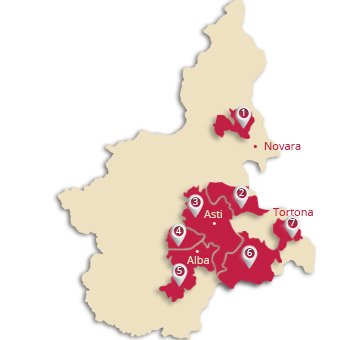Piemonte: cradle of Barolo

Our sommellier for Piemonte is Marco Tamborelli
Marco is Professional Sommelier A.I.S., he is graduated in Law, he has a passion for art and design and he works for a major winery in Piedmont.
Do you need more precise info about Piemonte ?
Questions, doubts, clarifications ?
Write Marco at m.tamborelli@wineshop.it
The cultivation of wine was introduced to Piedmont in the 4th or 5th century B.C. by the ancient Greeks, but it was "only" during the period of the Roman Empire that vineyards were distributed throughout the territory: in this period they perfected their cultivation techniques and built the first underground wine cellars to improve the quality of the wine. During the following centuries Piedmontese winemaking, although it went through an extensive mediocre period, especially during the Middle Ages, was always the most popular form of agriculture in the region, largely because it was the most profitable. In the 18th century, under the rule of the Savoia, Piedmontese winemaking acheived a new level of quality that would make it famous in the years to come. In present day, Piedmont is certainly one of the most prestigious wine regions in Italy, and according to many, the very best. In Piedmont, wine is synonymous with culture, with commitment and diligence, and with age old traditions. At the root of this success is certainly the favorable terrain, most of the territory being made up of rolling hills. Let's take a look at the principle zones.
First of all, let's begin with the jewel in the crown of Piedmont's wine culture: Langhe e Roero. This zone is particularly adapted to the cultivation of vineyards, the dry climate and hilly terrain are perfect for high quality production. The most prevalent grape is the Nebbiolo. The name is derived from the word "nebbia" (fog): in fact the vine produces a grape that undergoes a late maturation process when the first fog of the season settles upon the hills. This grape produces one of the best known wines of Italy, Barolo, the glory of Piedmont wines, which takes its name from it's place of origin. Created under the care of the marquis Faletti, this noble and robust wine ages particularly well: after twenty years it is still supremely drinkable. It is a red that is truly one of its kind, should be served at a temperature higher than 18° celsius, and, an interesting particular, it remains well conserved in the bottle even after its been uncorked.
South of the river Po, adjacent to Langhe e Roero, we find the Monferrato zone, divided into three sub-divisions, Monferrato Casalese, Monferrato Astigiano and Alto Monferrato. An area characterized by steeply descending hills, it owes its fame to four principle grapes that give the very best of themselves here: Barbera, Grignolino, Dolcetto and Moscato. Barbera, a grape of Piedmont origin, produces a vinuos red with a characteristic bouquet, in contrast with the Grignolino, which produces a red that is much more dry and delicate. Dolcetto, pleasing and mildly bitter, is produced here with incomparable results. Finally, Moscato is the base for a wine known throughout the world: l'Asti Spumante, produced in such enormous quantity that it makes up one third of Italy's spumante production.
To the north, just south of Lago d'Orta (Lake Orta) we find the zone of Colline Novaresi e Vercellesi, where two other champions of the Nebbiolo grape are produced: Gattinara and Ghemme. Big red wines with a characteristic violet bouquet, they equal Barolo in terms of aging extremely well. Each takes its name from its place of origin. Gattinara has been highly esteemed for literally centuries: it was a favorite of cardinal Mercurino Arborio, who introduced it with great success to the Imperial Court of Charles the V in the 16th century.
Click on any zone to discover its wines









